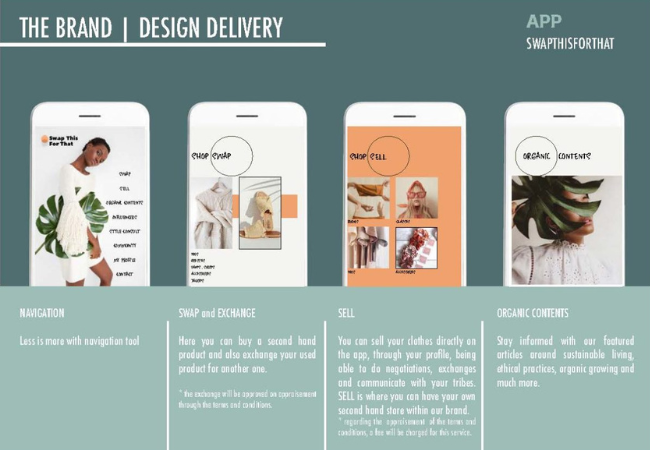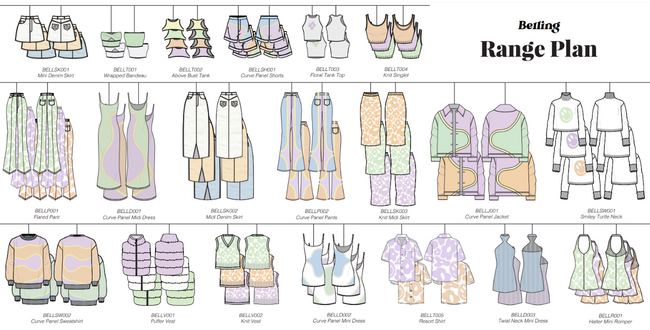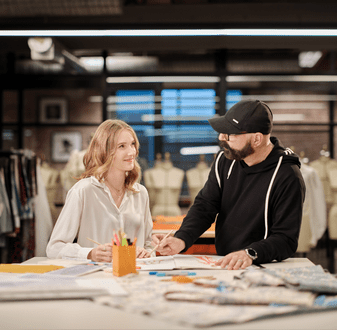Passionate about exploring sustainable fashion solutions or on a mission to create the perfect made to measure wide leg linen pant?
The fashion industry is enormous, spanning the entire globe and filling a range of niches. But there’s always room for someone new – someone with a dream. Someone like you.
Here are our top tips for starting up a clothing business – based on our own expertise and the lessons we’ve learnt by collaborating with the powerhouses of the fashion industry.
How to start up your own clothing business
Starting any new business requires you to narrow down options so you don’t take on too much all in one go, and starting clothing business options are as varied as the clothes and accessories you see people wear on any given street.
The practical steps to starting up your clothing business require you to research and identify your market. Once you’ve identified your place in the market, you’ll want to develop a business plan. This is really important, for a number of reasons. It will shape your focus and thinking now, and down the track – with your original goals there to guide you.
Our top tips for starting out in the fashion industry are:
- Develop an entrepreneurial mindset
- Understand the business models and strategies used in fashion
- Level up your marketing and branding skills
- Build up your industry knowledge and networks
- Gain knowledge in sustainable and ethical fashion enterprise practices
A Bachelor of Fashion Marketing and Enterprise will provide you with industry-standard skills and tools to develop and launch your own fashion brand and collection.

Credit: Camila Pisoni
Understanding fashion trends and concepts
Trend analysis and design development is an important part of running your own clothing brand, as you’ll need to anticipate what people will be buying and how to develop profitable collections.
From the outside, forecasting can sometimes look like magic, but it’s all about paying attention. The ability to analyse customer perceptions, understand garment construction practices and knowing how fashion supply chains work is critical.
Paying attention to colours, patterns, textiles and tech developments – like what’s happening with haptics in activewear and the Internet of Things (IoT) – will also help your brand stay relevant, and give you an abundance of fresh inspiration.
Keep sites like WGSN bookmarked. WGSN is the global authority on change, using expert trend forecasting combined with data science to help you get ahead of the right trends.

Credit: Georgia Bellingham
Getting your clothing manufactured and distributed
“I have a very small commission service,” says Bachelor of Branded Fashion Design graduate Katherine Jiang, who runs her own label, Indistinct. “The reason for all my returning clients is a well-constructed garment.”
There’s a level at which you can make all your own clothes and sell them locally on a small scale, through your online platforms, at a pop-up store or at local neighbourhood markets. Beyond that, you’ll want to look at more contemporary outsourcing and manufacturing options. This is where Tech and Spec packs are essential.
What are Tech and Spec packs? They’re one of fashion design’s hidden secrets, and they also happen to be one of our specialties. In fact, we dedicate an entire subject to the ins and outs of putting these packs together, and it’s the quality of these packs that are often the reason industry hire Billy Blue College of Design fashion graduates. You'll produce the Tech and Spec packs for your final collection, meaning your collection can go into production the very next day following your graduate showcase.
Whether you’re planning to have your range produced on- or offshore, Tech and Spec packs are made up of the documentation that tells your external contact everything they need to know about actually making your garments. Think of them like the equivalent of a recipe book – rules for your suppliers to follow when you can’t be there in person.
Putting in the work early to ensure all this information is present and correct will mean you can be clear in your negotiations and scheduling, with fewer issues further down the supply line.
It also means that you have a better chance of realising your artistic vision, without having to compromise on quality. That’s the benefit of learning your craft with the support of formal education that focuses on industry realities and practical concerns as well as the creative side of fashion design.
“It is very important to understand how you can transfer an amazing illustration into life, and eventually into a commercial product,” Katherine explains. “It is a dream for every artist and designer to present a product that is reflective of their ideas, but also commercially considered, to help their business and career thrive.”
What does it take to run a fashion brand?
Beyond the actual business of design and production, there are many elements to keep track of. Some of these you’ll focus on yourself, while other parts of the brand can be outsourced.
One way to immerse yourself in the industry, and gain experience with the ebb and flow of fashion trends, is to undertake an internship – like our Bachelor of Branded Fashion Design student Holly Villagra did last year at Vogue Australia.
“I cannot stress enough the importance of gaining industry experience as it allows you to gain a glimpse into the industry,” Holly says. “Having this knowledge allows you to be better prepared for your future in design. Following my experience at Vogue I can confidently say I am a better designer for it.”
There’s a reason we also offer the Bachelor of Fashion Marketing and Enterprise, which provides the leadership skills you need to operate a contemporary fashion organisation. Alongside developing a marketing strategy for your fashion brand, you’ll learn skills in putting together budgets, tracking profit and expenditure, and finding the best sources of material for the best price – all important elements in running a fashion brand, and how you approach them can vary.
“Billy Blue gave me the skills and confidence to keep all aspects of our business in-house,” says Virginia Mann, who started her own label in her final year of study. “Old Flame is proudly independent and we design every fabric print, graphic and tech pack.”
Finally, and importantly, the best way to run a fashion brand is ethically. Our Fashion Marketing and Enterprise courses and our Branded Fashion courses place a strong emphasis on learning to do things the right way and understanding the impact of the industry on both local and global communities . That might seem heavy at this stage, but as with so many elements of this career path, making better decisions at the outset can lead to massive rewards later down the line.
As a future fashion leader, you’ll be liaising with a variety of different stakeholders, from customers to designers, manufacturers to technologists. And, as you can see there are many fields within the fashion industry. Please contact us if you would like to discuss which option would be best for your future plans – we’re always very happy to help potential fashion moguls find a career they’ll love.




.png?rev=5cbecfb2b7c742e9b55997d971b951d8)